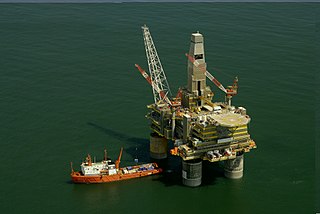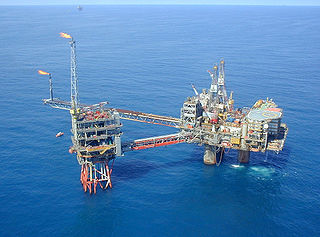
An oil platform is a large structure with facilities to extract and process petroleum and natural gas that lie in rock formations beneath the seabed. Many oil platforms will also have facilities to accommodate the workers, although it is also common to have a separate accommodation platform linked by bridge to the production platform. Most commonly, oil platforms engage in activities on the continental shelf, though they can also be used in lakes, inshore waters, and inland seas. Depending on the circumstances, the platform may be fixed to the ocean floor, consist of an artificial island, or float. In some arrangements the main facility may have storage facilities for the processed oil. Remote subsea wells may also be connected to a platform by flow lines and by umbilical connections. These sub-sea facilities may include one or more subsea wells or manifold centres for multiple wells.

The Troll A platform is a Condeep gravity-based structure offshore natural gas platform in the Troll gas field off the west coast of Norway. Built from reinforced concrete, as of 2014, it was the tallest structure that has ever been moved to another position, relative to the surface of the Earth, and is among the largest and most complex engineering projects in history. The platform was a televised sensation when it was towed into the North Sea in 1995, where it is now operated by Equinor. It is also the heaviest object moved and the object with the second highest displacement at 1.2 million tons(the object with the highest displacement is the Gullfaks C, which had a displacement approaching 1.5 million tons). Troll A was towed from the afternoon 10 May 1995 until the platform was in place 17 May 1995. It was lowered to the seabed in 303 meters of water, and had penetrated 36 meters into the soil by 19 May 1995. It was self-supporting with no further mooring required.

The Statfjord oil field is a large oil and gas field covering 580 km2 along the U.K.-Norwegian boundary of the North Sea at a water depth of 145 m, discovered in 1974 by Mobil and since 1987 operated by Equinor.

Gullfaks is an oil and gas field in the Norwegian sector of the North Sea operated by Equinor. It was discovered in 1978, in block 34/10, at a water depth of 130-230 meters. The initial recoverable reserve is 2.1 billion barrels, and the remaining recoverable reserve in 2004 is 234 million barrels. This oil field reached peak production in 2001 at 180,000 barrels per day (29,000 m3/d). It has satellite fields Gullfaks South, Rimfaks, Skinfaks and Gullveig.
Oseberg is an offshore oil field with a gas cap in the North Sea located 140 km (87 mi) northwest of the city of Bergen on the southwestern coast of Norway. The field, which is 25 km long by 7 km wide, was discovered in 1979 and its development is known to be one of the significant milestones in emergence of Norway's independent oil and gas industry. The Oseberg field was named after Oseberg ship, one of Norway's most significant archeological discoveries. The ancient Viking ship from the early 9th century was discovered in a 1904 historical excavation of a burial mound at the Oseberg Farm, south of Oslo.

Snorre is an oil and gas field in the Tampen area in the southern part of the Norwegian Sea. The sea depth in the area is 300 to 350 metres. Snorre has been operational since August 1992. It was the first field developed by Saga Petroleum.

Troll is a natural gas and oil field in the Norwegian sector of the North Sea, one of the biggest in the North Sea, holding 40% of Norway’s gas – it also possesses significant quantities of oil, in thin zones under the gas cap, to the west of the field. The field as a whole consists of the main Troll East and Troll West structures in blocks 31/2, 31/3, 31/5 and 31/6, about 65 kilometres (40 mi) west of Kollsnes, near Bergen. Most of the gas lies in Troll East.

A gravity-based structure (GBS) is a support structure held in place by gravity, most notably offshore oil platforms. These structures are often constructed in fjords due to their protected area and sufficient depth.

Condeep is a make of gravity-based structure for oil platforms invented and patented by engineer Olav Mo in 1972, which were fabricated by Norwegian Contractors in Stavanger, Norway. Condeep is an abbreviation for concrete deep water structure. A Condeep usually consists of a base of concrete oil storage tanks from which one, three or four concrete shafts rise. The Condeep base always rests on the sea floor, and the shafts rise to about 30 meters above the sea level. The platform deck itself is not a part of the construction.

The East Shetland Basin is a major oil-producing area of the North Sea between Scotland and Norway. It extends from 60°10′ N to 61°45′ N and 1°36′ E to 3°0′ E. It is 111.3 km north–south and at its maximum 55.8 km east–west.
Vats or Vatne is a village in Vindafjord municipality in Rogaland county, Norway. The village is located in the traditional district of Haugalandet between the southern end of the lake Vatsvatnet and the northern end of the Vatsfjorden. It sits about 10 kilometres (6.2 mi) southwest of the village of Sandeid and about 12 kilometres (7.5 mi) southeast of the village of Skjold. Vats Church is located in this village.
CHC Helikopter Service, previously CHC Norway, CHC Helikopter Service and Helikopter Service is the Norwegian division of CHC Helicopter Corporation. The airline was an independent company until 1999. It operates primarily to oil platforms on the Norwegian continental shelf in the North Sea and the Norwegian Sea, with crew change, infield shuttle and search and rescue operations. Though the global headquarters are in Richmond, B.C., Canada, the company has its main base at Stavanger Airport, Sola.

Europipe II is a natural gas pipeline from the Kårstø processing plant north of Stavanger to a receiving terminal at Dornum in Germany. It came on stream on 1 October 1999.
Sleipner A is a combined accommodations, production and processing offshore platform at the Sleipner East gas field in the Norwegian sector of the North Sea. It is a Condeep-type oil platform, built in Norway by the company Norwegian Contractors for Equinor.
The Statpipe pipeline is a natural gas system, which links northern North Sea gas fields with Norway's gas export system. It transports gas from Statfjord, Gullfaks, Heimdal, Veslefrikk, Snorre, Brage and Tordis gas fields.
Offshore concrete structures, or concrete offshore structures, are structures built from reinforced concrete for use in the offshore marine environment. They serve the same purpose as their steel counterparts in oil and gas production and storage. The first concrete oil platform was installed in the North Sea in the Ekofisk oil field in 1973 by Phillips Petroleum, and they have become a significant part of the marine construction industry. Since then at least 47 major concrete offshore structures have been built.
Braathens Helikopter A/S was a Norwegian helicopter airline based at Stavanger Airport and Bergen Airport. It used a fleet of seven Aérospatiale Super Pumas to serve offshore oil platforms in the North Sea. The customers were Amoco, BP, Norsk Hydro, Phillips Petroleum and Statoil, serving their oil fields Ekofisk, Oseberg, Gullfaks, Veslefrikk, Valhall, Ula and Gyda. Braathens Helikopter operated from 1989 to 1993, after which it was sold to and merged with the main competitor, Helikopter Service. Braathens Helikopter was owned by Ludvig G. Braathens Rederi and was a sister company of the airline Braathens SAFE.

Suction caissons are a form of fixed platform anchor in the form of an open bottomed tube embedded in the sediment and sealed at the top while in use so that lifting forces generate a pressure differential that holds the caisson down. They have a number of advantages over conventional offshore foundations, mainly being quicker to install than deep foundation piles and being easier to remove during decommissioning. Suction caissons are now used extensively worldwide for anchoring large offshore installations, like oil platforms, offshore drillings and accommodation platforms to the seafloor at great depths. In recent years, suction caissons have also seen usage for offshore wind turbines in shallower waters.
Sesam is a software suite for structural and hydrodynamic analysis of ships and offshore structures. It is based on the displacement formulation of the Finite Element Method.
Hywind Tampen is a floating offshore wind farm 140 km off the Norwegian coast in the North Sea owned by the Norwegian state-owned energy company, Equinor. The turbines are mounted on cylindrical concrete spar-buoy foundations.








